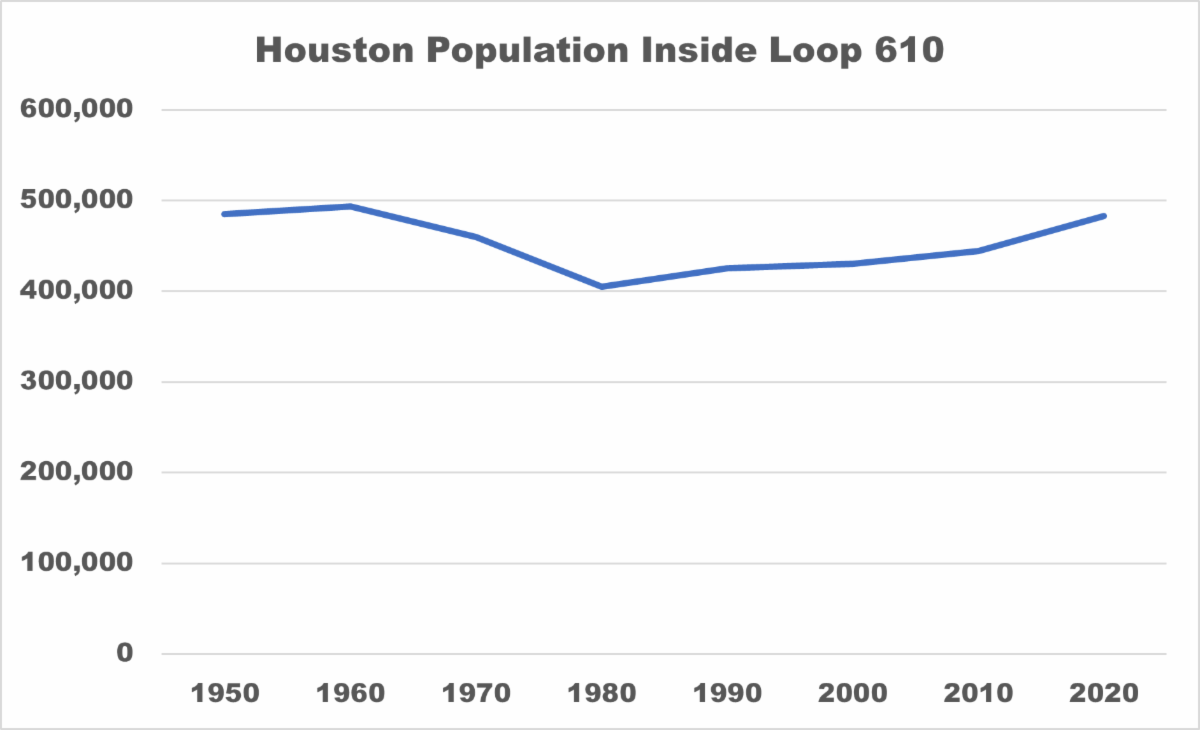There is a persistent urban myth that Houston’s core is densifying. But the Census data shows that has not been the case. A decade ago, the City Planning Department did an analysis of demographics of the city inside Loop 610 that largely went unnoticed.
The most surprising finding of the analysis was that from 1950 through 2010, the population inside the Loop actually declined by about 10% (485,000→443,000). I pulled the 2020 census data to see what happened over the last decade. Based on my analysis, the population moved back up to about 483,000, about the same as 1950.1

I have used this statistic a number of times in presentations. People are always incredulous. With all the building that has taken place inside the Loop in the last 70 years, how can it be that the population is unchanged? The answer is that buildings are equivalent to population. In middle of the last century there were thriving neighborhoods like Sunnyside, Manchester and Houston Trinity Gardens. There was block after block of tract houses with a mom, a dad and several children. Those neighborhoods today have much lower population with relatively few families and many abandoned houses.
Even though many apartments and high rises have been built inside the Loop, most of those apartments are occupied by a single person or a couple. There are very few families. Until recently, I lived in a 31-story high rise in the Galleria. There were 42 full-time residents.
This statistic is even more important when you compare the population inside the Loop to the City’s total population. In 1950, the people living inside the Loop were 81% of the City’s population. Today they are 21%.
Of course, annexation played a big part in this relative comparison as the City aggressively pushed in corporate limits outward. However, annexations mostly came to a halt in 1999 when the Legislature made it much more difficult for a city to annex additional land. The change in the law largely came about as a response to the City’s annexation of Kingwood.
The most important takeaway from this statistic is that the common belief that Houston’s core has been densifying is a myth. At about 5,000 residents per square mile, Houston’s core is one of the least dense urban cores in the U.S. More importantly, if the core did not densify during the time that the City’s population quadrupled, it never will do so, especially considering the tepid population growth we can expect in the future.
This reality has many implications, but none more profound than for transit. For years we have heard from transit advocates that if we build high intensity transit, such as light rail, the City will densify around it. Since the early 2000’s Metro has invested over $2.3 billion in light rail, which is located entirely within the Loop. Yet the population has remained stagnant.
Houston is facing many challenges, some of them daunting. We must plan and invest in a future that is based on facts, not urban myths or the dreams of some who wish Houston had developed differently. Here is one fact that you can take to the bank. Houston will never, let me repeat that, never be significantly more dense or urban than it is right now. To base our planning or investments on some imagined/hoped for alternative reality is a fool’s errand. And one that we cannot afford.

